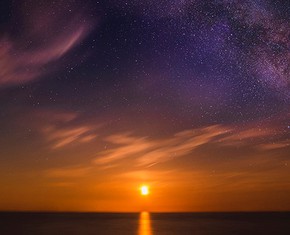The views expressed in our content reflect individual perspectives and do not represent the authoritative views of the Baha'i Faith.
And I saw a new heaven and a new earth: for the first heaven and the first earth were passed away; and there was no more sea. And I John saw the holy city, new Jerusalem, coming down from God out of heaven, prepared as a bride adorned for her husband. And I heard a great voice out of heaven saying, Behold, the tabernacle of God is with men, and he will dwell with them, and they shall be his people, and God himself shall be with them, and be their God. . . .
And he carried me away in the spirit to a great and high mountain, and shewed me that great city, the holy Jerusalem, descending out of heaven from God, Having the glory of God: and her light was like unto a stone most precious, even like a jasper stone, clear as crystal; . . . And the building of the wall of it was of jasper: and the city was pure gold, like unto clear glass. And the foundations of the wall of the city were garnished with all manner of precious stones. The first foundation was jasper; the second, sapphire; the third, a chalcedony; the fourth, an emerald; The fifth, sardonyx; the sixth, sardius; the seventh, chrysolite; the eighth, beryl; the ninth, a topaz; the tenth, a chrysoprasus; the eleventh, a jacinth; the twelfth, an amethyst. And the twelve gates were twelve pearls; every several gate was of one pearl: and the street of the city was pure gold, as it were transparent glass.
And I saw no temple therein: for the Lord God Almighty and the Lamb are the temple of it. And the city had no need of the sun, neither of the moon, to shine in it: for the glory of God did lighten it. — Revelation 21: 1–3, 10–11, 18–23a.
This prophecy is from the Book of Revelation, the last book of the Bible. It means what it says. But does it say what it means? Let’s take a closer look.
Prophecies talk about persons and places. Here, the place is the “New Jerusalem” (Rev. 21:2). This “place” obviously looks a lot different from present-day Jerusalem. Not only are the streets paved with gold, but “the city was pure gold.” Sound impossible? Probably so.
Now prepare yourself for a new thought: the New Jerusalem is not a place. It’s a new Prophet.
“Holy smokes!” you might justifiably exclaim. “How can this be? You’d better explain. And give me some good reasons!”
Okay. Get ready for a mind-bending train of reasoning! First, consider these three fundamental principles of prophecy:
- Prophecy was made by Prophets (in the past).
- Prophecy was made for Prophets (in the future).
- Prophets were not made for prophecy.
In other prophecies in other religious traditions, there are surreal cities with fantastic descriptions comparable to those of the New Jerusalem. For instance, in Shia Islam, the Hidden Imam, who has been in “occultation” for well over a thousand years, will appear on the Day of Resurrection from the twin cities of Jabulqa and Jabulsa. Descriptions of these cities are quite out of this world, as Baha’u’llah explains:
But the Imams of the Faith have fixed His abode in the city of Jabulqa, which they have depicted in strange and marvellous signs. To interpret this city according to the literal meaning of the tradition would indeed prove impossible, nor can such a city ever be found. Wert thou to search the uttermost corners of the earth, nay probe its length and breadth for as long as God’s eternity hath lasted and His sovereignty will endure, thou wouldst never find a city such as they have described, for the entirety of the earth could neither contain nor encompass it. . . . Since this is not in thy power, thou hast no recourse but to interpret symbolically the accounts and traditions that have been reported from these luminous souls. And, as such an interpretation is needed for the traditions pertaining to the aforementioned city, so too is it required for this holy Being. – Baha’u’llah, Gems of Divine Mysteries, pp. 36–37 (emphasis added).
Note here that Baha’u’llah’s reasoning perfectly exemplifies Step 1 (“If impossible, then not literal”): “To interpret this city according to the literal meaning of the tradition would indeed prove impossible.” Baha’u’llah’s argument then illustrates Steps 2 and 3 (“If not literal, then figurative” and “If figurative, then symbolic”): “Since this is not in thy power, thou hast no recourse but to interpret symbolically the accounts and traditions that have been reported from these luminous souls.” Then, as to the New Jerusalem, Baha’u’llah’s interpretation is a perfect analogy to Step 4 (“If symbolic, then spiritual and social. Who (or what) represents those qualities?”) Baha’u’llah proclaims:
Thus have We built the Temple with the hands of power and might, could ye but know it. This is the Temple promised unto you in the Book. Draw ye nigh unto it. This is that which profiteth you, could ye but comprehend it. Be fair, O peoples of the earth! Which is preferable, this, or a temple which is built of clay? Set your faces towards it. Thus have ye been commanded by God, the Help in Peril, the Self-Subsisting. Follow ye His bidding, and praise ye God, your Lord, for that which He hath bestowed upon you. He, verily, is the Truth. No God is there but He. He revealeth what He pleaseth, through His words “Be and it is”. – Baha’u’llah, The Summons of the Lord of Hosts, p. 137 (emphasis added).
Similarly, Abdu’l-Baha explains:
Clearly, the New Jerusalem which descends from heaven is not a city of stone and lime, of brick and mortar, but is rather the religion of God which descends from heaven and is described as new. For it is obvious that the Jerusalem which is built of stone and mortar does not descend from heaven and is not renewed, but that what is renewed is the religion of God. – Abdu’l-Baha, Some Answered Questions (new translation).
The “glory of God” is mentioned twice in the above passage from Revelation, in verses 11 and 22, as if for emphasis: “Having the glory of God” and “for the glory of God did lighten it.”
This “glory of God” would “dwell” “with men”: “Behold, the tabernacle of God is with men, and he will dwell with them” (verse 3). A walking, talking “tabernacle of God”? This is person, not a place, for “I saw no temple therein.” So the “tabernacle of God” is not a “temple.”
The new temple is even referred to by name: “for the glory of God did lighten it.” Baha’u’llah’s name literally means the “Glory of God.”
There’s even a Baha’i prayer for the New Jerusalem! Here it is:
O Thou kind God! In the utmost state of humility and submission do we entreat and supplicate at Thy threshold, seeking Thine endless confirmations and illimitable assistance. O Thou Lord! Regenerate these souls, and confer upon them a new life. Animate the spirits, inform the hearts, open the eyes, and make the ears attentive. From Thine ancient treasury confer a new being and animus, and from Thy preexistent abode assist them to attain to new confirmations.
O God! Verily, the world is in need of reformation. Bestow upon it a new existence. Give it newness of thoughts, and reveal unto it heavenly sciences. Breathe into it a fresh spirit, and grant unto it a holier and higher purpose.
O God! Verily, Thou hast made this century radiant, and in it Thou hast manifested Thy merciful effulgence. Thou hast effaced the darkness of superstitions and permitted the light of assurance to shine. O God! Grant that these servants may be acceptable at Thy threshold. Reveal a new heaven, and spread out a new earth for habitation. Let a new Jerusalem descend from on high. Bestow new thoughts, new life upon mankind. Endow souls with new perceptions, and confer upon them new virtues. Verily, Thou art the Almighty, the Powerful. Thou art the Giver, the Generous. – Abdu’l-Baha, Promulgation of Universal Peace, p. 276 (emphasis added).
















Comments
Sign in or create an account
Continue with Googleor